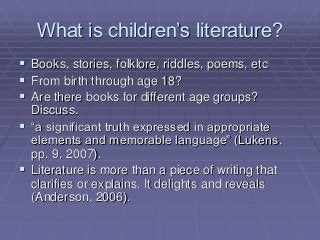
What-is-children-s-literature-ppt.ppt
- 1. What is children’s literature? Books, stories, folklore, riddles, poems, etc From birth through age 18? Are there books for different age groups? Discuss. “a significant truth expressed in appropriate elements and memorable language” (Lukens, pp. 9, 2007). Literature is more than a piece of writing that clarifies or explains. It delights and reveals (Anderson, 2006).
- 2. What differentiates between children and adult literature Children Simpler expression of ideas. Simple vocabulary Attention span Stories are told more directly with r/ship among characters shown clearly. Children more open to experimenting with more forms of literature than adults. Children find spontaneous pleasure in rhymes & jokes, cartoons, comics, etc. Adults tend to stick to one type of literature.
- 3. “Read, read, read. Read everything”- william Faulkner
- 4. Different genres of children’s literature A genre is a kind or type of literature that has a common set of characteristics. A genre is a grouping of books with similar style, form, or content. The same term is used for movies, music, plays, TV shows, artwork, etc. They often overlap, especially those of Early childhood.
- 5. Genres of children’s literature (according to Anderson, 2006) Children’s Literature Concept books Alphabet books Counting books Pattern picture books Wordless picture books Fiction Fantasy Animal fantasy Contemporary fiction Historical fiction Science fiction Traditional Literature Myths Fables Folk songs Legends Tall tales Fairy tales Traditional rhymes Biography & autobiography Informational books Poetry & verse.
- 6. Book format- another form of classification Book format refers to the way a book is put together or looks. Wordless picture books, Easy-to-read books. Illustrated books Chapter books Hardcover books Paperback books Grocery store books Series books
- 7. History of Children’s literature Up until the 19th century books written for children were entirely religious, instructional, or for the improvement of their morals and manners. What do you know about how children were viewed prior to the inception of child development as a discipline? The views about children then influenced nature of lit.
- 8. History (cont’d) In 1865 Alice in Wonderland” was written, the first book that was written for mere enjoyment. & that marked the beginning of children’s literature
- 9. Differences between children’s books now and then More experimentations with genres- from teaching values to fantasy, fiction, etc Blurring age boundaries- picture bks for everyone. Changing topics, eg., technology, terrorism Technology & commercialization, bks on audio and videotapes.: eg. Harry Potter. Increasing diversity melting pot vs salad bowl. International literature. Building on the past, looking into the future. Question: should we change the style of books to meet needs of American audience?
- 10. Students to go to lib & categorize bks. Students to work in gps to talk about what bks for which children.